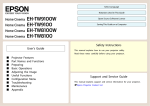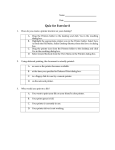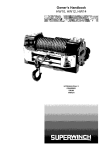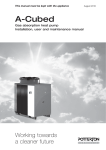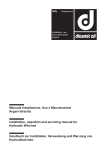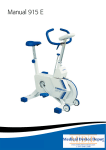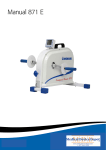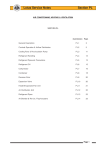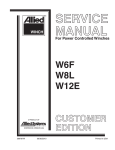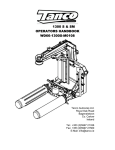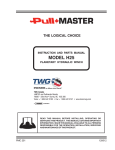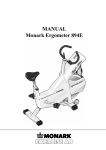Download SEPDURANCE SEPMATIC FORCEMATIC SEPGAIN
Transcript
Vehicle Recovery Winch - hydraulically driven SEPDURANCE SEPMATIC FORCEMATIC SEPGAIN Original User Manual 1 Introduction 1.1 General Its SEPSON’s objective, focus and single purpose to build reliable, dependable and uncomplicated winches that will require a minimum of maintenance and are simple to repair if this is ever needed. They are quickly and easily attached on any vehicle chassis. SEPSON hydraulic vehicle recovery winches from the product groups – SEPDURANCE, SEPMATIC, FORCEMATIC as well as the worm gear driven SEPGAIN series, will meet all rescue and recovery requirements The SEPDURANCE winches represent the core of our range of drum winches and are characterized by these features. All drum winches: • have drum and housing made of nodular cast iron for added strength and structural integrity • have the free spooling feature to easily allow a manual unspooling of the wire rope and a unique 2-speed feature controlled by a hydraulic valve system is also standard on all models with a pulling force of 150 kN and above • are equipped with a spring applied, pressure release multi-disk brake and the optimal drum-to-wire-rope diameter ratio of minimum 10:1 which significantly increases the useful life of the rope and reduces operating expenses. The SEPMATIC winches are the next step up on the ladder to higher performance and feature an integrated spooling attachment. The FORCEMATIC range is our most advanced family of winches which are have been equipped with a unique feature that maintains a constant pulling force on the wire rope regardless of its layer on the rope drum. 3 1.2 About this manual This manual contains important data concerning the maintenance, installation and operation of SEPSON winches. Should anyone assigned the task to attach the winch on a vehicle be uncertain about how to perform the task, please contact SEPSON. The information in this manual is based on current information available to SEPSON at this time. Under no circumstance, should this information override or replace national or international statutory instructions, regulations and safety precautions. Caution This symbol indicates that the information in a relevant paragraph must be observed and understood. Please contact SEPSON if there is any doubt regarding a “caution” or “warning” frame. WARNING This warning symbol alerts to a clear and present danger and must be observed and understood at all times. Do not proceed with the winching operation if there is any doubt about the meaning of this warning! 4 2 Safety The winch must only be used for vehicle recovery and loading. 2.1 Introduction This introduction describes and explains the safety precautions that must be observed and provides useful and necessary information. Read this chapter very carefully. It is important to fully understand its content and purpose. It concerns your safety as well as the safety of others around you in the working area of the rescue and recovery operation and the safe utilization of the winch. Familiarize yourself with the winch by practising its use before attempting to save or rescue a vehicle. This is important and will help you understand its different functions and ensure that you will be able to operate the equipment with optimal safety. 5 2.2 Safety symbols Signs with the symbols below shall be attached on or at the winch operating device(s). If a remote control is used the symbols shall be attached on the hand held control unit. General warning Eye protection must be used Head protection must be used Hand protection must be used Safety boots must be used Read the manual before operating the winch 6 OUT Winching out (attached at the direction control valve - remote control) IN Winching in (attached at the direction control valve - remote control) Freespool clutch (attached at the freespool control) A label showing drum rotation when spooling in the rope on the drum is attached on the winch by Sepson prior to shipment. Sepson is delivering a sheet with self gluing symbols with the winch to be attached on the operating device by the winch installer. 7 2.3 Winch markings 0078-01 Machine plate (See 2.4 Machine plate). The placement of the marks varies between different winch models. 8 2.4 Machine plate 0079-01 1. Winch model – Sepdurance, Sepmatic, Forcematic or Sepgain 2. Product number 3. Maximum allowed oil pressure to the winch. A higher pressure can seriously damage the winch and give excessive pulling force 4. Maximum allowed oil flow to the winch. A higher oil flow can seriously damage the winch 5. Required electrical current for the winch if applicable 6. Diameter of steel wire rope 7. Maximum length of steel wire rope on the winch 9 8. Minimum breaking load (MBL) for the winch wire rope stated by the wire rope manufacturer 9. Recommended oil or grease for the winch 10. Manufacturing year 11. Manufacturing number 12. Weight of winch excluding steel wire rope 13. Maximum pulling force on the bottom rope layer 14. Maximum pulling force on the top rope layer 15. Maximum allowed load weight when lifting on the bottom rope layer 16. Maximum allowed load weight when lifting on the top rope layer 17. Maximum allowed number of rope layers on the winch drum 18. If Yes is marked does the specified wire rope comply with EU-standard 19. If No is marked does not the specified wire rope comply with EU-standard and the winch is delivered for use in countries outside the European Union with other safety standard 10 2.5 General information WARNING Operation of the winch requires a skilled operator. Any use of the winch may create risks of injuries to the operator and the general safety of people in the area as well as damage to the winch itself and other equipment used in connection with its operation. It is only the operator’s awareness of the necessary safety precautions and his/her sound judgment that can eliminate or reduce the risks of personal injuries. It is the responsibility of the operator to ensure that all appropriate precautions are taken as required by the working environment and conditions in each individual case. Neither this document nor observing and applying its instructions absolve the operator or owner from their joint responsibilities to ensure the actual implementation of all precautions or the observance of all warnings. If anyone becomes aware of any SEPSON supplied product or SEPSON originated design that can create a risk to an individual working with or within the vicinity of the product, it is an obligation to contact SEPSON immediately. It is the user’s responsibility to make all relevant hazard identifications and risk assessment of all activities associated with the use of both the product and this document. It is solely the user’s and the owner’s joint responsibility to provide a safe working environment and to provide the necessary safety equipment and ensure that everybody who is depending on this document, understands the instructions, warnings and caution and that they are able to operate the equipment in accordance with these instructions. Should an operator lack the knowledge, experience or skills to work in accordance with the safety or other instructions in this document, immediate assistance should be requested from SEPSON. Technical assistance sought from SEPSON will be subject to SEPSON terms and conditions. 11 2.6 Personal Protective Equipment It is absolutely essential that the operator uses the appropriate and required safety equipment when working with the equipment. This includes: 1. Head protection (Hard hat) 2. Protective clothing 3. Hand protection (Heavy duty gloves when handling with the rope and rubber gloves when working with oil) 4. Eye protection (Goggles) 5. Safety boots (Steel tipped and slip resistant sole) 1 4 2 3 5 0063-01 Protective clothing should protect the operator(s) against oil and shield from accidental contact with the wire rope. Avoid loose clothing that may be caught in the winch or the wire rope and cause serious injury. Personal safety equipment does not eliminate the risk of injury but reduces the risk and effects in case of an accident. It is only the user’s awareness of all safety risks and his/her own judgment that will provide the necessary safety margins against personal injury. 12 2.7 Precautions Always make sure that nobody unauthorized is in the hazard area marked with yellow and absolutely no one in the high risk zone marked with red in these illustrations before starting the winch operation. 0020-01 0020-03 13 Always follow and observe SEPSON’s and the vehicle manufacturer’s advice and instructions with regards to the recommended location of the winch. The hydraulic system and its applications require care and cleanliness. Always observe and respect SEPSON assembly and installation instructions. WARNING Never use the winch to move people and never use it as a hoist to lift objects. WARNING Keep hands clear of the wire rope and all attaching components during installation, pulling process and when spooling the wire rope in or out on the drum. Always handle the wire rope by the rope end when spooling out the rope by hand. The first step is to create a safe working environment for each specific pull. There are several aspects to consider depending on restrictions imposed by the surroundings and the locations of the vehicles. – Remove any objects that may be blocking the operation or prevent a clear view of the pull path. – Try to place the winch at in a straight line in front of the load. – Never try to pull the load sideways. – If necessary, use pulley blocks or other devices to change the pulling direction or its angle to the winch. – Take all necessary time to plan the pulling operation and gather available information such as the load (weight) and the surroundings (surface condition) before the operation takes place. – Consider all important issues that might impact the winching operation and which may be important factors in calculating the pull and in determining the need for special equipment. 14 – Always wear heavy duty protective gloves when handling the rope and never let it slide through the palm of your hands while spooling, because wire strands may cause painful injury. – If a remote control is installed, always keep the control unit with you when leaving the winch unattended. – Always attach the wire rope to a point on the object that will support the winch’s maximum capacity. WARNING Always handle the wire rope with gloves and pull on any device attached to the rope end when spooling in or out by hand. WARNING When pulling out the rope, always leave at least the length of three (3) revolutions on the drum. Caution Always pull out the wire rope manually with the drum in the free spooling position. Never run out the rope under power. Caution Never hook the wire rope on to itself, it will cause damage. Caution Never fill the hydraulic oil tank with more than 80% of capacity to leave 20% space for the liquid for heat expansion. 15 Caution Always put a load on the rope when spooling to the drum otherwise the rope will not spool correctly. WARNING Always inspect the wire rope’s attaching point at the load side and its condition before operating the winch. WARNING Damaged wire ropes or attaching devices must be replaced before the pull. WARNING Always stand clear of the rope and respect the danger zone. – Make sure everybody is aware of your intention to pull the load and outside the danger zone. WARNING Make sure that the rope is slack before unhooking after the pull. There is a clear danger of injury from the rope’s rotation. 16 3 Installation 3.1 General The winch is designed for pulling operations in recovery and rescue and is designed for mounting on a vehicle chassis only. Please refer to the technical information for more detailed specification on this particular winch model. 3.2 Mounting on vehicle The winch is either mounted with a mounting plate or directly to the vehicles chassis. When a mounting plate is required, the plate must support the force of twice the maximum pulling force of the winch. Refer to instructions about the use and dimensions of a mounting plate in the Technical information for your winch. If in doubt, always seek the advice and instructions from both SEPSON and the vehicle’s manufacturer. – The emergency stop shall cut out the power supply to the winch(es). – Never mount operating device close to the exhaust pipe(s). – Handholds and platform for maintenance work shall be installed if needed for safe work. SEPSON is not liable for the winch installation on the vehicle. 17 3.3 Lifting the winch Lifting straps Lifting eye 0014-02 0070-01 Separate the straps on the drum as much as possible. Caution The winch is too heavy for handling by hand. Use an adequate lifting device and do not place lifting straps around the hydraulic motor or the hydraulic valve block. Please refer to the technical information to obtain the exact weight of this winch 1. Remove the rope from the drum and refer to instructions under rope installation. 2. Create a rope sling around the drum. 3. Place the loop sling into the lifting device. 4. Check the balance before lifting. 5. Lift the winch. If the winch is supplied with thread bolt holes for lifting eyes use lifting eyes. 18 3.4 Hydraulic installation Auto 2-speed block Single speed block V 2 V 1 M V 2 V1 V 1 V2 0033-01 0066-01 WARNING All seals must be in place to protect the operator and anybody else in the area against an escape of high oil pressure. 1. Connect the directional control valve and the winch by the ports V1 and V2 on the hydraulic block. 2. Inspect and test all tubing, hoses and connection points for oil leakage. If the directional control valve is attached to the winch, connect the pressure hose/tube to the pressure inlet and the return hose/tube to the oil outlet on the control valve. The directional control valve must have an open centre; otherwise the winch safety brake will not operate properly or not at all. Make sure that the hydraulic system is set to not deliver higher oil pressure and oil flow as listed in the technical information section for the winch. 19 3.5 Pneumatic or hydraulic free spooling control installation Connect the freespooling control to the winch according to the circuit. It is a 1/4” threaded connection on the winch’s freespooling cylinder. 3 - If the winch has a pneumatic freespooling control, the air pressure shall be 6-10 bar. 2 - If the winch has a hydraulic freespooling control the oil pressure must not exceed 40 bar. Check freespool clutch. 1 0018-01 1. Air/oil supply 2. Control Valve 3. Free spooling valve Minimum allowed movement of the freespool clutch Art. No mm Art. No mm 73.06- 73.0760.08- 60.15-60.16- 16 73.09- 9 63.01- 63.02- 21 63.53- 10 63.35- 11 62.56- 12 63.31- 9 63.34- 13 The different connection points for the Sepson winch groups are shown below, the arrow points at the connection point. 20 Art.no Art.no 73.0673.0760.0860.1560.16- 73.09- 0049-01 63.0163.02- 0050-01 63.53- 0051-01 63.35- 0052-01 62.5462.56- 0053-01 0054-01 63.3163.34- 0019-01 21 3.6 Rope installation Caution Always wear protective gloves when handling the rope. Never install a wire rope that does not meet the requirements in technical information for this winch. The new rope must be uncoiled from the spool on the ground prior to installation. 0024-01 22 Wedge Lock 1. Thread the end of the rope through the wedge rope grip from its narrow end. 2. Bend the rope end around the wedge rope grip and form a loop. 3. Place the rope key inside the loop. 4. Insert the rope key inside the rope pocket. 0026-01 5. Hold the rope firmly inside the pocket and pull firmly to insert the rope key and rope loop inside the slot on the drum. 6. Make certain that both the rope key and the loop are entirely inserted into the rope pocket on the drum. 7. Now wind the rope on carefully on the drum while maintaining a pull on the rope itself. Make certain that the rope ends wind up close together. 23 Screw Lock 1. Thread the end of the rope through the hole furthest from the drum flange and pull about 1 metre through (enough for 3 turns on the drum). 2. Wind the free end 3 turns on to the drum toward the flange by hand as tightly as possible. 3. Pass the free end through the hole nearest to the flange and make sure it goes right to the end of the hole. 4. Secure the end of the rope in this hole by tightening the locking screw. 5. Now wind the rope on carefully on the drum while maintaining a pull on the rope itself. Make certain that the rope ends wind up close together. 0055-01 Wind the rope on the drum to exit either above or below as required. 0056-01 24 3.7 Electrical installation WARNING The emergency stop shall cut out the power supply to the winches. – For installation of electric components see attached appendix – For installation of remote control see attached appendix Recommendations: – Install illumination for the controls at the operation station and working lights 3.8 After installation Test all functions to see if they work properly before using the winch. Check: – Control (moves easily) – Emergency stop (function) – Wire rope and attached devices (free from damages) – Hydraulic system (no oil leakage) – Level of hydraulic oil in the oil tank (tank filled to 80%) – Illumination 25 4 Winch basics 4.1 Hydraulic System Basic Information 4.1.1 General Hydraulics is the process in the context of applied science and engineering that deals with the mechanical properties of liquids. Fluid mechanics provide the foundation for all hydraulic systems including the SEPSON winches. 4.1.2 Outline Diagram for Installation of Winch Hydraulics 7 9 5 6 4 8 3 2 11 10 12 1 14 13 0071-01 26 Note The directional control valve is shown in 2 views. In the illustration is only one valve. 1. Remote control (optional) 2. Connection box (optional) 3. Switch for pneumatic freespool clutch 4. Connection for pneumatic freespool clutch 5. Winch 6. Hydraulic pipe Ø 16 mm or hydraulic hose ½” 7. Hydraulic pipe Ø 16 mm or hydraulic hose ½” 8. Return hose 1” 9. Hydraulic tank with return filter and air filter 10. Suction hose 2” 11. Hydraulic pump 12. Pressure hose ¾” 13. Directional control valve If the maximum allowed oil flow cannot be automatically set by either adjusting the maximum rpm for the engine or by a flow control function in the directional control valve, then an oil flow limiting valve needs to be installed in the pressure line before the directional control valve. If a cable remote control is used the valve must be electro pneumatically or electrically controlled and with Hirschman or Deutsch contact 14. Ball valve assembly 27 4.1.3 Hydraulic Oil Temperature The oil temperature should be between + 30°C and + 60°C during normal operation. Oil life is greatly reduced if its temperature exceeds + 60°C. As a role general rule, oil life is halved for each 8°C its temperature exceeds +60°C. If the oil temperature exceeds 80°C the seals in the hydraulic system can get damaged and the life time for the seals is reduced. If the temperature is below minus 20°C disengage the rope drum from the drive chain and run the winch for 5 - 10 minutes. Viscosity The viscosity for the oil should be between 20 mm2/s and 75 mm2/s (100 and 370 SUS) when the operating temperature of the system has become stabilised. We recommend the use of an oil type having a viscosity of 35 mm2/s (165 SUS) at the actual operating temperature. Filtering It is necessary to keep the level of oil contamination at an acceptable level to ensure problem free operation. The recommended maximum level of contamination in the hydraulic winch system is 20/16 (See ISO 4066). In our experience the 20/16 contamination level can be met by using a return 20 µm absolute or 10 µm nominal filter. 28 4.1.4 Power Supply The Sepson hydraulic driven winches are designed to be supplied with hydraulic oil at a pressure of 160 – 210 bar and with and oil flow of 50 – 70 litres per minute. • The oil pressure and the flow must not exceed the maximum indicated values in the data sheets for the winch. An increase in pressure or flow will increase the power and might damage the winch. • The oil flow must not be below 30 litres per minute. At a lower flow, the winch will not operate properly. • If a load sensing hydraulic system is used contact Sepson for advice on choice of control valve. • The hydraulic oil must be of good quality and clean. • The oil tank must have a capacity adequate for the conditions under which the winch is being used. The ambient temperature is of significant importance and should determine the volume of the tank’s capacity. 29 4.1.5 Heat Generation All hydraulic driven systems generate heat and the hydraulic oil will overheat if an oil cooler of sufficient capacity is not used. As a general rule, 30 – 40% of the input energy is lost as heat in vehicle mounted winch systems. If the temperature of the hydraulic oil rises above 80°C, the seals in the system might be damaged and the lifetime shorten. The increase of oil temperature in a vehicle mounted hydraulic winch system without any cooling can be calculated according to this formula: 1.25 × p × q × t ΔT ≈ ------------------------------------V Where: 30 ΔT = Temperature increase in degrees C° p = Oil pressure in bar q = Oil flow in liters per minute t = Running time in hours (part of hour) at oil pressure p V = Oil tank volume in litres 4.1.6 How to dimension an oil cooler The capacity in kW for an oil cooler is calculated at a difference between ambient temperature and the temperature of the hydraulic oil of 40°C. To operate a hydraulic winch system without heating the hydraulic oil the required capacity in kW for the oil cooler can be calculated as: 0.35 × p × q P ≈ ----------------------------600 Where: P = Capacity in kW p = Oil pressure in bar q = Oil flow in litres per minute A winch system is seldom run at full power during long periods of time. As a general rule, when calculating required cooling capacity, the oil pressure (p) should be set to 50 – 75% of the max pressure for the winch system. Note, that a winch system with a small tank requires an oil cooler with a higher capacity than a system with a bigger tank. 31 4.1.7 Pulling force and rope speed The relief valve in the hydraulic system starts to open when the hydraulic pressure reaches 80% of the maximum oil pressure set for the winch. At maximum oil pressure the relief valve will be fully open and the winch stalls. Rope speed Rope Speed versus Pulling Force Pulling Force 32 4.1.8 Hydraulic Function Diagram Auto-2-speed winches with two or more motors Winching in at high speed Oil in at V1. The shuttle valve C opens and permits oil flow to measuring point E and to the brake F which releases when the pressure exceeds 30 bar. The pilot line G leads oil to the Over Centre Valve D. This valve opens at approximately 60 bar so that oil from the motor can return to the tank. In case the Over Centre Valve D does not open from the pilot pressure, a pressure of approx. 270 bar is required to force the oil backwards through the valve (load holding function). The oil drives the motor M1 and passes through the Over Centre Valve D and to V2. 0038-01 (Red lines in the circuit diagrams = oil flow. Green lines = only pressure). 33 Winching in at low speed Oil in at V1. The shuttle valve C opens and permits oil flow to measuring point E and to the brake F which releases when the pressure exceeds 30 bar. The pilot line G leads oil to the Over Centre Valve D. This valve opens at approximately 60 bar so that oil from the motor can return to the tank. In case the Over Centre Valve D does not open from the pilot pressure, a pressure of approx. 270 bar is required to force the oil backwards through the valve (load holding function). The oil drives the motor M1 and passes through the Over Centre Valve D and to V2. When the oil pressure exceeds approx. 90 bar, the sequence valve H opens and permits oil flow to all motors. 0039-01 (Red lines in the circuit diagrams = oil flow. Green lines = only pressure). 34 Winching out Oil in at V2. The shuttle valve C opens and permits oil flow to measuring point E and to the brake F which releases when the pressure exceeds 30 bar. The pilot line K leads oil to the Over Centre Valve L. This valve opens at approximately 70 bar so that oil from the motor can return to the tank. In case the Over Centre Valve L does not open from the pilot pressure, a pressure of approx. 315 bar is required to force the oil backwards through the valve (load holding function). The oil flows to all motors M1-3 and passes through Over Centre Valve L and out through V1. 0040-01 (Red lines in the circuit diagrams = oil flow. Green lines = only pressure). 35 Diagram for 2-speed hydraulic system 1 1.3 1.1.4 2.2 1.1 1.1.3 1.1.1 1.1.2 1.2 V2 V1 B A 2.1 2 T 3.4 3.3 3.2 P 3.1 3 0003-02 Position Part 1 Winch with hydraulics 1.1 Hydraulic block Combining sequence valve, double overcentre valve, shuttle valve and pressure gauge outlet mounted direct on to one of the motors. The ports marked V1 and V2 are for the hydraulic connections from the control valve on the vehicle´s hydraulic system. They both have R 3/4" thread. 1.1.1 Sequence valve This automatically regulates the rope speed and pulling force of the winch. It is adjusted and sealed before leaving the factory. 36 Explanation 1.1.2 Double overcentre valve This allows the load to be spooled out at a controlled rate. It also provides burst hose protection. It is adjusted and sealed in our factory. 1.1.3 Shuttle valve Supplies pressure for the spring loaded brakes and the pressure gauge outlet on the block. 1.1.4 Pressure gauge outlet R 1/4" female threaded connection. 1.2 Hydraulic motors 1.3 Hydraulic spring loaded brake. 2 Control valve unit 2.1 Directional control valve 4-way, 3 position with spring-centred motorised spool and built-in pressure reducing valve. The ports A and B must have at least R 1/2" threaded connections and the ports P and T at least R 3/4". 2.2 Pressure reducing valve Must be pilot controlled, set to maximum allowed pressure for the winch and be sealed at installation. 3 Hydraulic oil supply unit 3.1 Hydraulic pump 3.2 Hydraulic oil tank This automatically brakes the load when the control valve is put in the neutral position or if the oil pressure is lost. The pump must be able to deliver required oil flow and oil pressure for the winch.The pump is direct mounted to the vehicle PTO. Fixed pump and load sensing or variable pump requires different directional control valve. 37 3.3 Return oil filter Must filter to 10 microns or better and accept required oil flow. 3.4 Pipe, hoses and connectors Must be approved for min. 21 MPa (210 bar) working pressure and have the following dimensions: - Pump inlet line min. 1 1/4" - Return line min. 1" - Pressure lines hose 1/2" - 3/4" - pipes min. Ø16 x 2 mm - Pilot line, pipe min. Ø8 x 1 mm 38 Single Speed Winches with one motor Winching in Oil in at V1 The shuttle valve C opens and permits oil flow to measuring point E and to the brake F which releases when the pressure exceeds 30 bar. The pilot line G leads oil to the Over Centre Valve D. This valve opens at approximately 60 bar so that oil from the motor can return to the tank. In case the Over Centre Valve D does not open from the pilot pressure, a pressure of approx. 270 bar is required to force the oil backwards through the valve (load holding function). The oil drives the motor M1 and passes through the Over Centre Valve D and to V2. 0041-01 (Red lines in the circuit diagrams = oil flow. Green lines = only pressure). 39 Winching out Oil in at V2 The shuttle valve C opens and permits oil flow to measuring point E and to the brake F which releases when the pressure exceeds 30 bar. The pilot line K leads oil to the Over Centre Valve L. This valve opens at approximately 70 bar so that oil from the motor can return to the tank. In case the Over Centre Valve L does not open from the pilot pressure, a pressure of approx. 315 bar is required to force the oil backwards through the valve (load holding function). This means that if the winch rope is pulled backwards, a load of 1.5-2 times the winch rated pulling force is required to move it backwards, depending on rope layer. The oil flows to the motor M1 and passes through Over Centre Valve L and out through V1. 0042-01 (Red lines in the circuit diagrams = oil flow. Green lines = only pressure). 40 Diagram for single speed hydraulic system 1 1.3 1.1.4 1.1.3 2.2 1.1.2 1.2 V2 V1 B A 2.1 2 1.1 T 3.4 3.3 3.2 P 3.1 3 0003-01 Position Part Explanation 1 Winch with hydraulics 1.1 Hydraulic block Double overcentre valve, shuttle valve and pressure gauge outlet mounted direct on to one of the motors. The ports marked V1 and V2 are for the hydraulic connections from the control valve on the vehicle´s hydraulic system. They both have R 1/2” or 3/4" thread. 1.1.2 Double overcentre valve This allows the load to be spooled out at a controlled rate. It also provides burst hose protection. It is adjusted and sealed in our factory. 41 1.1.3 Shuttle valve Supplies pressure for the spring loaded brakes and the pressure gauge outlet on the block. 1.1.4 Pressure gauge outlet R 1/4" female threaded connection. (Not on all winch models). 1.2 Hydraulic motor 1.3 Hydraulic spring loaded brake 2 Control valve unit 2.1 Directional control valve 4-way, 3 position with spring-centred motorised spool and built-in pressure reducing valve. The ports A and B must have at least R 1/2" threaded connections and the ports P and T at least R 3/4". 2.2 Pressure reducing valve Must be pilot controlled, set to maximum allowed pressure for the winch and be sealed at installation. 3 Hydraulic oil supply unit 3.1 Hydraulic pump 3.2 Hydraulic oil tank 3.3 Return oil filter 42 This automatically brakes the load when the control valve is put in the neutral position or if the oil pressure is lost. The pump must be able to deliver required oil flow and oil pressure for the winch. The pump is direct mounted to the vehicle PTO. Fixed pump and load sensing or variable pump requires different directional control valve. Must filter to 10 microns or better and accept required oil flow. 3.4 Pipe, hose and connectors Must be approved for min. 21 MPa (210 bar) working pressure and have the following dimensions: - Pump inlet line min. 1 1/4" - Return line min. 1" - Pressure lines hose 1/2" - 3/4" - pipes min. Ø16 x 2 mm - Pilot line, pipe min. Ø8 x 1 mm 43 4.2 How to calculate required pulling force The required pulling force (RPF) can be calculated according the formula: M ( sin α + Rr ) × ( 1 + Ff ) g RPF ( kN ) = ---------------------------------------------------------------1000 Where: 44 M = the loads weight in kg α = gradient stated in degrees Rr = roll resistance Ff = friction factor for rope sheaves and pulley blocks etc. g ≈ 10 (correct 9.8) M The gross weight in kg for the object that shall be pulled. α The surface gradient. α = 10° ( ≈ 18% ) sin α = 0.17 α = 15° ( ≈ 27% ) sin α = 0.26 α = 20° ( ≈ 36% ) sin α = 0.34 α = 25° ( ≈ 47% ) sin α = 0.42 α = 30° ( ≈ 58% ) sin α = 0.50 Rr Ff The roll resistance for wheeled and tracked vehicles on different surfaces. (For a tracked vehicle with immobilised tracks increase the values given below with 40%) Firm road = 0.050 Grass = 0.175 Gravel = 0.250 Sand = 0.325 Shallow mud = 0.425 Deep mud = 0.625 The friction factor depends of number of rope sheaves and rope guides. Calculate with a loss of 2% of the pulling force for each 45° turn of the rope. For a pulley block with 180° turn of the rope the loss of pulling force is approx. 8-10%. Add 5% for adverse conditions. 45 Example: A vehicle is stuck in sand in a slope with an inclination of 15°. The Vehicle weight is 2000 kg. A pulley block is used for a 90° pull. 0045-01 2000 ( 0.26 + 0.325 ) × ( 1 + 0.09 )10 M ( sin α + Rr ) × ( 1 + Ff ) g RPF = ---------------------------------------------------------------- = --------------------------------------------------------------------------------------- = 12.8kN 1000 1000 A pulling force of 12.8 kN ( ≈ 1.3 T) is required. 46 4.3 Good rope spooling on a drum winch It is very essential that the rope is spooled on with as small an angle as possible to a line drawn at square angle from the centre of the rope drum (A). The fleet angle (a) in the sketch below should not be much greater than 2° to obtain a perfect spooling. If this angle is bigger than 5° a good spooling cannot be obtained. The rope spool not properly and on to one side of the rope drum. d (A) (a) D 0048-01 The distance (D) from centre of the rope drum till the first rope sheave or roller fairlead shall in the best case be 10 times the drum width (d) and absolutely not less than 5 times the drum width (d). If the distance is less than 5 times, is will be impossible to get a good rope spooling. If the distance is between 5 – 10 times the drum width (d), rope spooling problems may occur and mainly on the top rope layers. For winches with spooling attachment the fleet angle can be as much as 15° corresponding to a relation between D/d of 2. When installing a drum winch, mount the winch as far as possible from the first rope sheave or roller fairlead. Choose a winch with a drum width that allows you to have the smallest possible fleet angle. Observe that a narrow drum need more rope layers for the same length of rope than a wider drum and that the pulling force is reduced with the number of rope layers unless a constant pulling force device is used. It will always compromise between fleet angle and the least number of rope layers. 47 4.4 Wire rope selection WARNING Never use a damaged rope. In doubt contact your rope supplier or Sepson. During the useful life of a winch, the wire rope replacement costs are often the highest expenditure. It is very important to select a rope that corresponds to the intended use of the winch itself. The majority of accidents that happen during the use of a winch are also caused by the wire rope and the selection of the appropriate wire rope becomes an important safety precaution. The wire rope’s minimum breaking load must be at least twice the load capacity of the winch itself unless national standards and requirements demand a different ratio of rope capacity vs the winch’s load limits. The wire rope will spool on to the winch drum. To lessen the probability of an accident and to minimize the premature wear of the rope, it is important to comply with the rule that the rope does bend or curve not less than ten (10) times the rope diameter. (----------------D + d )≥ 10 d Where: D = Winch drum diameter d = Rope diameter To obtain the best rope economy, it is recommended that it has a steel core and is cross-wound. 48 The wire rope should have at least six (6) strands and in a case where it will be passed through several line guides, a higher number of strands are recommended. A wire rope with fewer strands may be more resistant to wear whereas a rope with a higher number of strands is more flexible and bends easier through the guides which will make it more user-friendly. 1 2 0064-01 1. Core 2. Strands A compacted rope will have a longer useful life since damage will be avoided because with the rope’s smoother surface. 1 2 00064-02 1. Conventional 2. Compacted 49 If a swivel device is installed on the rope end, the use of a rotation resistant design cannot be used and consequently if a non-rotation rope is selected, a swivel device cannot be installed. In a case where the wire rope is guided through a number of line guides, it is important that the guide wheels diameter are at least ten (10) times the rope’s diameter. If minor adjustments of the line path are necessary, a smaller diameter of the guide wheels or rollers can be acceptable. Avoid large and frequent changes of the line path because this will increase the rope wear and cause a loss of pulling power. Avoid also “Z” bends because these will significantly impact the rope’s useful life. Frequent cleaning and lubrication will contribute to good wire rope economy. Corrosion reduces the rope life. 50 4.5 Rigging instructions WARNING Before starting the recovery, it is important that all safety instructions are observed and that nobody is within the hazard zone. WARNING These guidelines and instructions do not eliminate or replace the operator’s full and unlimited responsibility for the safety and protection of both people and material during all rescue and recovery operations. The following illustrations are examples of rigging recovery operations. Never forget that operations of this kind can cause damage or injury to people not only in within the danger zone. If you doubt, never hesitate to consult someone with experience from recovery of vehicles in such or similar situations. 0004-01 Block the recovery area according to national traffic regulations. Always try to have the wire rope in an approximately straight line between the recovery vehicle and the object to be recovered. 51 Always use pulley blocks if it’s not possible to have the wire an approximately straight line between the vehicles. A complicated location of the object to be recovered can require the use of more than one recovery vehicle. 0043-01 4kN 2kN 2kN 0043-02 Use double rope to increase the pulling capacity by attaching the free end of the wire rope to a fix point on the vehicle or another fix point. Attach the pulley block to the load that shall be recovered and winch in the rope. 52 0044-01 1. Anchor point 2. Pulley block 3. Recovery object 1 4. Winch 2 5. High hazard zone 4 3 5 0044-02 Use a pulley block to reduce the required pulling force. This will also enable better control of the recovery. 53 0045-01 1. Winch 4 2. Wire block 3. Recovery object 4. High hazard zone 1 2 3 0045-02 Should a reasonably straight wire rope between the recovery vehicle and the object to be recovered not be possible, always use pulley blocks. 54 . 0046-01 1. Winch 2. Double wire blocks 3. Recovery object 4. High hazard zone Use of multiple wire blocks for multiple force 1 2 3 4 0046-02 A relatively small winch can frequently manage to pull significantly heavier loads due to the multiple increase of its power with the use of pulley blocks. 55 0047-01 1. Pulling winch 2. Anchor point 3. Pulley block 1 6 4. Recovery object 5. Holding winch 2 4 3 6. High hazard zone 5 0047-02 A complicated location of the object to be recovered can require the use of more than one recovery vehicle. 56 5 Operating instructions Operation of the winch requires skilled operator. For how to handle the remote control see additional instructions. WARNING Keep hands clear of the rope and all attaching devices during installation, pulling operations and when spooling the rope in. 5.1 General Before a recovery operation is begun, be sure that you have read and understood this manual. Check: – Control (moves easily) – Emergency stop (function) – Wire rope and attached devices (free from damages) – Hydraulic system (no oil leakage) – Level of hydraulic oil in the oil tank (tank filled to 80%) – Illumination of the working area (if dark) – That long wire ropes are marked with flag(s) – That roads are blocked according to national traffic regulation if the winch rope is drawn over a road – That the hazard zone is clear from people With heavy loads, always work with the bottom wire rope layer on the drum to avoid that underlying rope layers become damaged by the rope section under load which can push through underlying layers and cause damage. 57 Never overload the wire rope. The minimum breaking load applies only to a new and unused rope and remember also that the securing devices may not be designed to withstand the maximum pulling power of the winch. 15º 15º 0022-02 Never pull at an angle of more than 15 degrees on either side of the drum. Place the winch in a straight line in front of the load if possible or use pulley blocks. Also always use pulley blocks if you are not certain about the weight of the load about to be pulled. This will reduce the pulling force and enable a better control of the operation. If a bigger angle than 15% is required use a rope sheave or a pulley block. 58 5.2 Pull out rope WARNING Always handle the rope in the hook when spooling in or out by hand. Be careful not to place hands in the rope eye or the attaching hook. 1. Freespool the winch drum. Manual freespool control Pull out the handle for the freespool control. Pneumatic or hydraulic freespool control Freespool the drum by using the electrical control switch. 2. Pull out the rope manually. Always pull out the rope manually with the drum disengaged. Never run the rope while under power. Always leave enough rope on the drum for at least three revolutions. Check the drum brake before attempting to use it. If it does not respond correctly, please refer to the information in the chapter Drum brake. The purpose of this brake is to avoid and prevent the drum from continuing to turn when unwinding the rope in a free spooling operation. 59 The different manual handles for the Sepson winch groups are shown below. 1. Pull 2. Turn Art.no Art.no 73.0673.0760.0860.1560.16- 73.091 1 2 2 0057-01 63.0163.02- 0058-01 63.3163.34- 1 2 1 2 0060-01 63.3563.53- 62.5262.56- 0061-01 60 0059-01 0062-01 5.3 Attaching the load WARNING Always use adequate equipment that is designed to withstand the maximum pulling force for the winch. 0007-01 Attach the wire rope in a secure place on the object to be pulled. Never hook the wire rope on to itself, it may damage the wire. 61 5.4 Engage the rope drum WARNING Make sure nobody is inside or close to the danger zone of the winch when during operation. Disengage the freespool Manual freespool control Release the handle for the freespool control. Pneumatic or hydraulic freespool control Engage the drum by using the electrical control switch. Activate the control valve and rotate the drum slightly until it is fully engaged. Make sure that the freespool clutch is fully engaged. To avoid jamming freespool cylinder, regular maintenance is required. See chapter Maintenance. 62 5.5 Pull the load 0009-01 1. Activate the control valve and continue pulling until the object is secured. 2. Stop the winch by releasing the control valve. The spring loaded brake and the double over centre valves will automatically hold the load in place. (A worm gear winch will hold the load without brake and over centre valves as it is self-braking). Note that the rope speed varies depending of load and rope layer on the winch drum. 63 5.6 Unhook the load 0009-02 WARNING Before unhooking the rope after pulling, make sure it is slack; otherwise there is a significant risk of injury from an uncontrolled rope rotation. 1. Spool out the rope for it to become slack before releasing it from the load. 2. Unhook the rope from the load. 64 5.7 Spool the rope back on the drum 0009-01 WARNING Always keep a pull on the rope when spooling it back on the drum otherwise it will not spool correctly. 1. Spool back the rope on the drum. 2. Keep a sufficient load in the rope to keep it stretched. 3. Check that the rope spools properly on the drum. 65 6 Maintenance WARNING Do not use a high pressure water to clean the winch as it may inject moisture into vital mechanical parts. It is of utmost importance that the cleanliness and lubrication of all moving parts are observed at all times. • • Wipe and lubricate the wire rope regularly (See rope manufacture’s recommendation) Check all hydraulic connections after each use. • A clean oil supply is also essential and important for the trouble free operation of the winch. • Inspect the mounting of the winch on the vehicle regularly and tighten all bolts and lock nuts. Note that hydraulic components can be very hot after operating the winch. Use protective gloves. 6.1 Gear drive On most winches, the gear drive is placed inside a permanently sealed enclosure. In a case where the enclosure needs to be unsealed, use CASTROL MS3 or LMX for hot climate or equivalent to refill. On some winches, the gear drive runs in an oil bath and this oil should be replaced every two years. Position of drain plug, filler hole and level plug is found in technical information for the winch. Check that there is no water condensation in the gear housing. Unscrew the draining plug in the bottom of the gear housing once a year and drain. Use protective gloves and collect the liquid in a vessel. 66 6.2 Drum brake Schedule a regular check of the friction drum brake components. The purpose of this brake is to avoid and prevent the drum from continuing to turn when unwinding the rope in a free spooling operation. The brake lining shall be replaced when the thickness is less than 1 mm. Art.no Art.no 0068-01 62.5462.56- 0069-01 63.35- 0073-01 63.53- 0074-01 73.07- 0075-01 0076-01 67 Art.no Art.no 73.09- 0077-01 To increase the brake effect, follow these steps: 1. Loosen the locking nut. 2. Turn the adjusting screws clockwise. 3. Tighten the locking nut. To reduce the brake effect, follow these steps: 1. Loosen the locking nut. 2. Turn the adjusting screws counter-clockwise a quarter turn. 3. Tighten the locking nut. 68 6.3 Spooling attachment The spooling attachment on winches with integrated rope spooling attachment shall be greased regularly – at least once a year. Use standard vehicle grease. The grease nipple is shown in picture. 0072-01 69 6.4 Freespool clutch WARNING Maintain and inspect freespool clutch regularly to avoid risk for lost payload. It is important that the freespool clutch is subject to regular and scheduled maintenance and that all functions are tested. Should any function fail, the freespool clutch will jeopardize the connection between the winch’s drive chain and rope drum. This creates a significant risk of injury to people as well as serious damage to the equipment and the payload because the operator’s control will be completely lost when the drum spins free from the clutch. The freespool clutch shall be lubricated on an easy to remember schedule such as each time the vehicle is being washed. It is extremely important that the winch is not used if the freespool function is not working properly. Contact an authorized repair centre of SEPSON immediately. Manual freespool Lubricate moving components with thin moisture-absorbing oil. Check that the freespool clutch has an unrestricted full movement annually or if suspected to not work properly. Pneumatic freespool Remove the air hose and spray thin moisture-absorbing oil into the system. Check that the freespool clutch has an unrestricted full movement. Check that the freespool clutch has an unrestricted full movement annually or if suspected to not work properly. Hydraulic freespool clutch Check that the freespool clutch has an unrestricted full movement annually or if suspected to not work properly. 70 Minimum allowed movement of the freespool clutch Art. No mm Art. No mm 73.06- 73.0760.08- 60.15- 60.1663.01- 63.0263.3563.31- 16 73.09- 9 21 11 9 63.5362.5663.34- 10 12 13 71 6.5 Wire rope WARNING A damaged or worn wire rope must be replaced. The design of the winch does not allow un-limit use of the wire rope. For ropes with 6 or 8 strands the most common wear is superficial thread breakage. For rotation resistant ropes is internal thread breakage most common and can not be seen from the outside. Discard criteria (examples) Strand jerk Snarl Basketing Flattening 72 7 Troubleshooting Sympton Probable cause Action 1. Winch does not function 1. No oil flow to winch – Check hydraulic oil level – Check all hydraulic lines, fittings and components for leaks 2. PTO not engaged – Engage PTO 3. Defective hydraulic motors – Replace motor or contact authorized service shop 4. Emergence stop button is engaged – Release the emergency stop 5. No electrical power – Inspect and repair electrical system 6. The freespool clutch is engaged – Disengage the freespool clutch 7. Hydraulic brake is not releasing – Check oil pressure at the inlet to the brake ( ≥ 30 bar). – Replace the hydraulic brake 8. Defect hydraulic pump – Replace pump or contact authorized repair service 73 2. Winch drum does not turn 3. The freespool clutch does not disengage the winch drum 4. The winch jerks or is noisy during operation 74 1. The drive train is not aligned and the freespool clutch can not connect the winch drum to the drive chain – Disengage the freespool clutch and rotate the drum till the drive chain engages 2. The return spring in the freespool clutch is damaged – Dismantle the freespool clutch or for some models the winch and replace the return spring. An authorized repair service should be used 3. The freespool cylinder is jammed in the freespool housing – Contact an authorized repair service 1. If pneumatic freespool clutch is used, insufficient air supply can be reason – Check the compressed air supply 2. If hydraulic freespool clutch is used, insufficient air supply can be reason – Check the oil supply 3. The winch is under load – Spool out the rope and unload 4. The freespool clutch is damaged – Contact an authorized repair service 1. Hydraulic pump is defective. – Replace pump or contact authorized repair service 2. Defective hydraulic motor – Replace motor or contact authorized repair service 3. Low hydraulic oil flow – Increase engine rpm 4. Hydraulic oil filter is dirty – Clean or replace filter 5. Air in hydraulic system – Ventilate hydraulic oil system 6. Control valve dirty – Clean control valve 7. Hydraulic brake is malfunctioning – Check oil pressure at the inlet to the brake ( ≥ 30 bar) – Replace the hydraulic brake 5. The winch will not reach required rope speed 1. Engine rpm too low – Increase engine rpm 2. Hydraulic oil filter dirty – Clean or replace filter 3. Defective hydraulic motor – Replace motor or contact authorized repair service 4. Hydraulic oil too hot – Let the oil cool down 5. Defective hydraulic pump – Replace pump or contact authorized repair service 75 6. Hydraulic oil is foaming 7. Winch does not pull rated load 76 6. Directional control valve defect – Clean or replace valve 1. Suction channel sucks air – Check connections 2. Oil return line ends over the oil surface in tank – Extend the return line 3. Ambient temperature too high for the hydraulic oil – Change to more heat resistant hydraulic oil or let the system cool down 1. System relief valve set to low – Check and set the relief pressure 8 Technical information 8.1 8.1.1 General Noise The A-weighted sound pressure level at winch operation place depends on the placement of the winch controls on the vehicle and type of vehicle. The noise level for the winch is ≤ 70 dB (A). 8.1.2 Vibration The vibration total value in the winch controls depends on the placement of the controls on the vehicle. The value is less than 2.5 m/s2 77 8.2 Design standard Sepson’s VEHICLE RECOVERY WINCHES are designed according to the following standards Directive 2006/42/EC Machinery (Harmonised C-standard) EN 14492-1:2006 Cranes – Power driven winches and hoists – Part 1: Power driven winches (Supporting safety standards) Safety of machinery – EN ISO 12100-1:2003 Basic concepts, general principles for design. Part 1: Basic terminology, methodology EN ISO 12100-2:2003 Safety of machinery – Basic concepts, general principles for design. Part 2: Technical principles EN 982+A1:2008 Hydraulic EN 983+A1:2008 Pneumatics EN 60204-1:2006 Electrical equipment of machines – Part 1: general requirement DIN 15020-1 Strength of gear transmissions EN 60529/A1:2000 Degrees of protection provided by enclosures (IP code) EN 13732-1:2006 Methods for the assessment of human responses to contact with surfaces – Part 1: Hot surfaces EN 13857:2008 Safety distances to prevent hazard zones being reach by upper and lower limbs Directive 92/58/EEG Safety and health signs at work 78 Sepson’s ELECTRICAL CONTROL SYSTEM and CABLE REMOTE CONTROLS are designed according to the following standards. Directive 99/5/EC Radio and telecommunications terminal equipment. (Supporting safety standards EMC and radio spectrum matters (ERM) EN 301489-1:2001 EN 301489-3:2001 EMC and radio spectrum matters (ERM) EN 300220-3:2000 EMC and radio spectrum matters (ERM) EN 61000-6-2:2005 EMC immunity EN 954-1: Safety related parts of control systems Military applications Applicable defence standards on request 79 8.3 EC declaration of conformity According to directive 2006/42/EG, Annex 2A Sepson AB SE-780 50 Vansbro, Sweden, declare under our sole responsibility that the products: Hydraulic winches in model series SEPDURANCE, SEPMATIC, FORCEMATIC and SEPGAIN from year of manufacturing 2010 and onwards following provisions of Directives: 2006/42/EG, Machinery 2004/104/EG, Electromagnetic compatibility to which this declaration relates is in conformity with the following standards and other normative documents: EN ISO 12100-1:2003, -2:2003, EN 14492-1:2006, EN 60204-32:1998, EN 301489-1, EN 301489-3. This declaration relates exclusively to the machinery in the state in which it was placed on the market and exclusively components which are added and/or operations carried out subsequently by final user. Ulf Jons, Head of Engineering, is authorised to compile the technical file. Vansbro May. 25, 2010. Mats Elfsberg CEO 80















































































